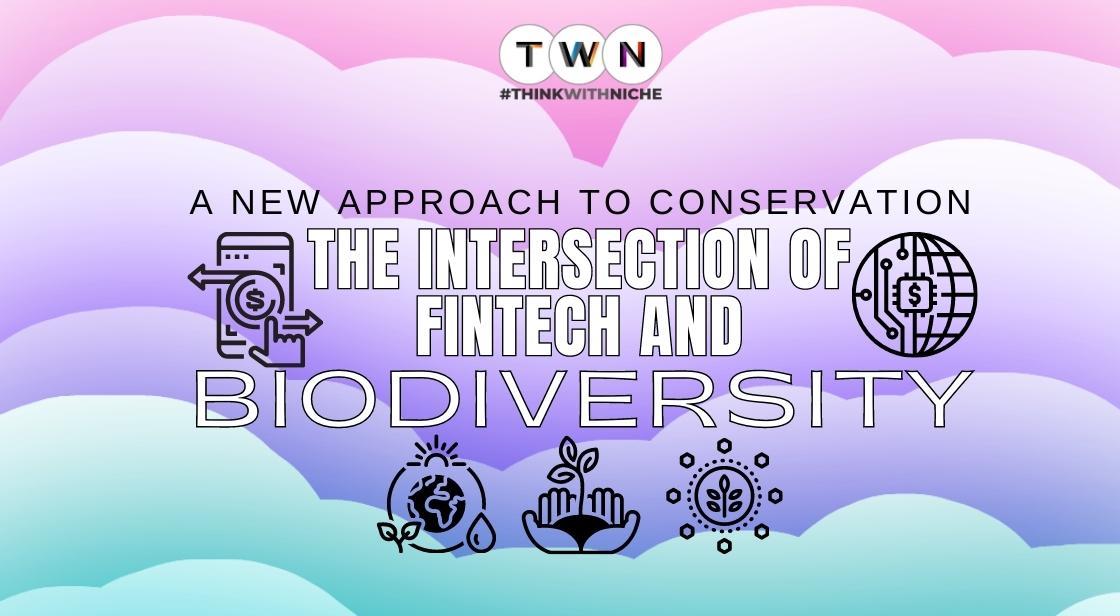The Role of FinTech in Promoting Biodiversity Conservation

Blog Post
Imagine a silent hero, a force that's revolutionizing the way we look at environmental sustainability. This hero is none other than the innovative world of Financial Technology, or as we fondly know it, FinTech.
A game-changer, not just about figures and finances, but an incredible tool for safeguarding our precious biodiversity.
When most people think of FinTech, they probably envision cutting-edge apps, digital currencies, and Wall Street traders glued to multiple screens.
However, there's another side to the FinTech coin that's just as impressive and arguably even more important: its role in promoting biodiversity conservation.
In this article, we'll delve into the significant, if not revolutionary, role FinTech plays in promoting biodiversity conservation. From driving sustainable practices to funding conservation initiatives, FinTech solutions are making a real and tangible impact on our environment.
A sector that's not just proving its worth but indeed, one whose value cannot be overstated.
So, let's embark on this exciting journey to discover how FinTech is contributing to the preservation and flourishing of our planet's biodiversity.
Ready to dive into the green heart of FinTech?
Imagine if your smartphone could save a rainforest. Sounds like a sci-fi plot twist, right? However, with the advent of financial technology, or FinTech, this futuristic fantasy is blossoming into reality.
FinTech, a dynamic blend of finance and technology, is not just about speeding up transactions or simplifying banking. It's morphing into a powerful ally in the global fight for biodiversity conservation.
"FinTech for Good is not just a catchy phrase. It's an evolutionary stride towards a sustainable future."
From crowdfunding conservation projects to leveraging blockchain for wildlife protection, FinTech is embedding itself into the heart of biodiversity preservation. Let's explore how this tech revolution is ushering in a green era, one digital innovation at a time.
The Role of FinTech in Promoting Biodiversity Conservation
Understanding the Intersection of FinTech and Biodiversity Conservation
In the heart of this digital era, there's a surprising alliance blooming - the fusion of financial technology (FinTech) and biodiversity conservation. It's a union that might not seem obvious at first glance, but upon closer inspection, the synergy is undeniable.
As we continue to grapple with environmental challenges, FinTech solutions are stepping up, offering innovative ways to support and promote biodiversity conservation.
FinTech, with its technologically-driven financial solutions, is not a sector traditionally associated with environmental causes. Yet, it's currently playing an instrumental role in funding conservation initiatives and promoting sustainable practices.
By leveraging the power of digital finance, we're successfully driving forward the much-needed positive environmental impact.
At the intersection of these two seemingly disparate fields, we find a vibrant space of possibilities. A space where technology and finance meet sustainability and environmentalism.
A space where FinTech is not just transforming the way we do business, but also how we protect and nurture our planet's precious biodiversity.
The Need for Innovative Funding Solutions for Biodiversity Conservation Projects
When it comes to biodiversity conservation, finding the funding to fuel these critical projects can often feel like searching for a needle in a haystack. Traditional funding methods, such as reliance on government grants and charitable donations, can be unpredictable and, quite frankly, insufficient. It's a pressing issue that requires an innovative solution - enter the dynamic world of FinTech.
FinTech, or financial technology, is shaking up the finance industry by offering new ways to manage, invest and raise funds. It's a digital revolution that's not just transforming our daily transactions but also opening new avenues towards sustainable practices and biodiversity conservation.
Investing in Nature, Digitally
From crowdfunding platforms to digital currencies, FinTech solutions are providing a fresh infusion of capital to biodiversity conservation. Crowdfunding, for instance, allows conservation projects to tap into a global network of environmentally conscious individuals willing to contribute to a cause they believe in.
Blockchain technology, the backbone of digital currencies, is also playing a pivotal role. Not only does it provide a secure and transparent way to manage funds, but it also allows for the creation of 'green' digital currencies. These currencies can then be used to incentivize sustainable practices and fund conservation initiatives.
Driving Conservation Through Data
FinTech isn’t just about funding, though. It’s also about data. Big data analytics, powered by advanced AI, is helping conservationists to make more informed decisions, predict trends, and track the impact of their efforts.
These insights can then be used to attract investors, demonstrate the effectiveness of conservation strategies, and ultimately, secure more funding for biodiversity conservation. It's a win-win situation – for the environment and for investors.
FinTech: A Sustainable Future
The marriage of FinTech and biodiversity conservation is a powerful one. It's providing innovative, effective, and scalable solutions to a global problem. And while there's still a long way to go, one thing’s for sure - FinTech is playing a crucial role in driving us towards a more sustainable future.
So next time you make a digital transaction, take a moment to think about how this technology could be contributing to the preservation of our planet's precious biodiversity. Because in the world of FinTech, every transaction can make a difference.
How FinTech is Enabling Microfinance for Local Conservation Efforts
Imagine a world where technology and finance merge to make a real impact on biodiversity conservation. That's the world FinTech is creating, and it's happening right now. Through the magic of microfinance, FinTech is offering a lifeline to local conservation efforts across the globe.
The Power of Digital Wallets
The role of FinTech in promoting microfinance for biodiversity conservation starts with the humble digital wallet. By enabling quick and easy transactions, digital wallets are proving to be a game-changer for grassroots conservation initiatives. They're breaking down financial barriers, making it easier to fund and implement local projects focused on preserving biodiversity.
Peer-to-Peer Lending: The FinTech Game Changer
But it's not just about digital wallets. Peer-to-peer lending platforms, a commendable innovation in the FinTech realm, are revolutionizing the way conservation projects are funded. They're creating global communities of lenders and borrowers, united in their mission to protect our planet's precious biodiversity.
Through these platforms, individuals and organizations can lend directly to conservation initiatives. It's a win-win situation, with lenders receiving a return on their investment and borrowers gaining the funds they need to make a real difference.
FinTech and Big Data: A Match Made in Conservation Heaven
FinTech's role in conservation doesn't stop at microfinance. It's also harnessing the power of big data to drive sustainable practices. By tracking and analyzing data on spending, donations, and investment trends, FinTech can identify where funding is most needed, making every dollar count in the fight to conserve biodiversity.
It's clear that FinTech has a vital role to play in promoting biodiversity conservation. By leveraging innovative financial solutions, it's helping to fund initiatives, drive sustainable practices, and create a more ecologically balanced world. And we're just getting started.
Blockchain: A Game-Changer for Sustainable Supply Chain Management
Let's dive into the world of blockchain, a groundbreaking tech that's making waves not just in finance, but in nature conservation too. It might seem like a leap, but hear me out. It’s all about creating transparent and sustainable supply chain management.
"The use of blockchain technology can reduce illegal fishing by up to 90%"
So, how does it work? Imagine a world where every product, from your morning coffee to your favorite pair of jeans, comes with a story. A story that you can verify, showing that the materials were sustainably sourced, the workers fairly paid, and the environment respected. That's the potential of blockchain.
Blockchain's decentralization takes the cake in this case. Its transparent, immutable ledger system allows for unparalleled traceability of goods. This means that companies can't just claim sustainability, they have to prove it.
But it's not just about transparency. Blockchain can directly contribute to biodiversity conservation. How? Through tokenization. In simple terms, tokenization involves turning rights to an asset into a digital token on a blockchain. Consider this in the context of conservation. Rights to a forest, for example, could be tokenized and sold to investors, creating a direct financial incentive for conservation.
Now, let's look at some real-world applications. One standout is the Blockchain for Climate Foundation, which is leveraging blockchain to enforce the Paris Agreement. By tokenizing countries' carbon emissions, the foundation is creating a clear, enforceable system for reducing greenhouse gases.
Then, there's Veridium Labs, a company that's tokenizing carbon credits. Their goal is to create a marketplace where companies can buy and sell carbon credits, encouraging businesses to offset their carbon emissions.
So, the next time you hear about blockchain, think beyond Bitcoin. Think biodiversity. Think conservation. The potential is enormous, and we're just scratching the surface.
Also Read: How to Achieve Sustainable Growth through the Circular Economy
Eco-Friendly Investing: How FinTech is Helping to Drive Positive Environmental Impact
Imagine a world where your investment portfolio not only generates great returns but also contributes to saving the planet. It's not a pipe dream, folks! Thanks to innovative FinTech solutions, eco-friendly investing is becoming more accessible than ever before.
FinTech, or financial technology, is using modern innovation to challenge traditional methods in the financial sector. And guess what? It's also proving to be a game-changer for biodiversity conservation.
How so, you ask? Let's dive right in.
FinTech and Sustainable Practices
FinTech is paving the way for sustainable practices in the investment world. How, you wonder? By promoting investments in companies that prioritize biodiversity conservation and environmental sustainability.
These FinTech platforms provide you with the necessary data to make informed decisions. They offer insights into a company's environmental impact, helping you avoid businesses that harm biodiversity.
FinTech Funding Conservation Initiatives
FinTech is also playing a pivotal role in funding conservation initiatives. Crowdfunding platforms enable people to financially support projects focused on preserving and restoring biodiversity.
Moreover, these platforms provide transparency. Donors can see exactly where their money is going, assuring them that their contributions are truly making a difference.
The Role of AI and Machine Learning in Biodiversity Conservation
Imagine AI-powered drones patrolling the skies to track endangered species, or machine learning models predicting shifts in ecosystems. That's not a page from a science fiction book. It's the new reality of biodiversity conservation, where artificial intelligence (AI) and machine learning (ML) are stepping up to play a significant role.
But, how exactly do AI and ML contribute to biodiversity conservation? Let's dive in and explore.
AI and ML: New Guardians of Biodiversity
AI and machine learning provide innovative tools to help conservationists monitor and protect biodiversity. These technologies can analyze vast amounts of data quickly and accurately, painting a precise picture of the world's biodiversity status.
Think of AI and ML as supercharged allies in the fight to preserve our planet's biodiversity.
Predictive Models and Simulation
Machine learning algorithms can generate predictive models to forecast ecosystem changes and species behavior. This ability allows us to proactively address potential threats and effectively manage conservation efforts. Sounds like time-traveling for biodiversity, doesn't it?
Tracking and Monitoring
AI-powered tools are excellent observers. They can monitor species populations, track migration patterns, and even detect poaching activities. All this information is crucial to creating effective conservation strategies.
It's like having a set of high-tech eyes in the sky, keeping a constant watch over our precious ecosystems.
Bringing Precision to Conservation
AI and machine learning bring a whole new level of precision to biodiversity conservation. We can now measure the impact of our conservation efforts accurately and make data-driven decisions.
As we continue to explore the possibilities AI and ML offer, one thing's clear: the future of biodiversity conservation is brighter, smarter, and more efficient with these technologies on our side.
Also Read: Tips for Maintaining Healthy Soil and Growing Nutrient-Rich Food: Sustainable Agriculture
Case Studies: Real-World Examples of FinTech's Impact on Biodiversity Conservation
FinTech, the meeting point of financial services and technology, is revolutionizing the world of biodiversity conservation. Its innovative applications are turning heads and making real-world impacts that can't be ignored. Let's dive into a few case studies that illustrate this surprising and inspiring trend.
1. The Rainforest Connection: Preventing Illegal Deforestation
With the help of FinTech, The Rainforest Connection is taking a stand against illegal deforestation. This startup has developed a unique solution for monitoring protected forest areas in real-time. They've transformed old cell phones into solar-powered devices that pick up the sound of chainsaws and alert local authorities.
The Rainforest Connection (RFC), a pioneering startup, continues to make significant strides in its mission to prevent illegal deforestation with the aid of FinTech solutions. Building on its innovative approach, RFC has further enhanced its monitoring capabilities to protect precious forest areas from unauthorized logging activities.
Utilizing the power of FinTech, RFC has developed an advanced system that combines artificial intelligence (AI) algorithms, machine learning, and real-time data analytics to detect and respond to instances of illegal deforestation. The heart of this system lies in the transformation of old cell phones into solar-powered devices that act as acoustic monitoring devices.
These solar-powered devices, equipped with specialized sensors and AI algorithms, can detect the distinct sound signatures of chainsaws and other illegal logging activities. Once detected, the devices immediately transmit the audio data to RFC's centralized platform, where it undergoes analysis in real-time.
Through machine learning algorithms, the system can accurately distinguish between natural sounds and those associated with illegal deforestation, ensuring a high level of accuracy.
The real-time monitoring capabilities of RFC's FinTech-powered system enable swift response and intervention. When illegal logging activities are detected, alerts are immediately sent to local authorities, empowering them to take timely action and prevent further damage to the forest ecosystem. The combination of FinTech and AI has revolutionized the fight against illegal deforestation by providing an effective early warning system.
RFC's innovative solution has garnered significant attention and support from conservation organizations, governments, and technology enthusiasts worldwide. The scalability and cost-effectiveness of their approach make it an attractive tool for protecting forested areas and preserving biodiversity.
Recent data showcases the impact of RFC's FinTech-powered system in preventing illegal deforestation. Through its network of solar-powered acoustic monitoring devices, RFC has successfully detected and reported numerous instances of illegal logging, leading to the apprehension of perpetrators and the preservation of vast forested areas.
The real-time data provided by the system not only aids in law enforcement efforts but also contributes to raising awareness about the pressing issue of deforestation and its impact on biodiversity.
As RFC continues to refine its FinTech solution, incorporating the latest advancements in AI and machine learning, the fight against illegal deforestation gains a powerful ally. The combination of technology and environmental conservation demonstrates the potential for FinTech to make a tangible difference in protecting our planet's vital forest ecosystems.
In recent years, RFCx has expanded its operations to new rainforests around the world. They have also developed new technologies to improve the effectiveness of their system. For example, they have developed a new software that can detect the sound of chainsaws from even further away.
In 2022, RFCx announced that they had detected over 1 million illegal logging events in the rainforests of Indonesia, Peru, and the Democratic Republic of the Congo. They also announced that they had helped to reduce illegal logging by an estimated 20% in these rainforests.
RFC's success story highlights the transformative potential of FinTech in addressing pressing environmental challenges. By leveraging innovative technologies and approaches, such as AI-powered acoustic monitoring, FinTech is empowering conservationists and local authorities to combat illegal deforestation effectively.
This fusion of finance and technology is paving the way for a more sustainable future, where advanced tools and real-time data play a vital role in biodiversity conservation.
2. Althelia Ecosphere: Funding Conservation with Sustainable Investments
Fintech is also playing a crucial role in funding conservation initiatives. Take the example of Althelia Ecosphere. This impact investment fund utilizes FinTech solutions to raise capital for projects that reduce emissions and promote biodiversity conservation.
Althelia Ecosphere, an influential impact investment fund, continues to demonstrate its commitment to funding conservation initiatives through the utilization of FinTech solutions. With a strong focus on reducing emissions and promoting biodiversity conservation, Althelia Ecosphere leverages innovative financial technologies to raise capital for projects that have a positive environmental impact.
In recent years, Althelia Ecosphere has witnessed significant growth and success in mobilizing funds through its FinTech-powered approach. By tapping into the growing interest in sustainable investments, the fund has been able to attract a diverse range of investors who prioritize environmental conservation alongside financial returns.
Through its FinTech platform, Althelia Ecosphere provides a streamlined and transparent investment process, connecting investors directly with conservation projects that align with their values and sustainability goals.
The platform leverages cutting-edge technologies, including blockchain and smart contracts, to ensure transparency, traceability, and secure transactions.
Here are some latest information and data about Althelia Ecosphere:
- In 2022, Althelia Ecosphere announced that it had raised €1 billion for its second fund. This fund will be used to finance projects that reduce emissions and promote biodiversity conservation in Africa, Asia, and Latin America.
- The fund has also been successful in attracting institutional investors, such as pension funds and insurance companies. This is a sign that there is growing demand for impact investments that address environmental and social challenges.
- Althelia Ecosphere is also working on a number of innovative projects that use FinTech to scale up conservation efforts. For example, the fund is developing a blockchain-based platform that will allow investors to track the impact of their investments.
Althelia Ecosphere is a leading example of how FinTech can be used to fund conservation initiatives. The fund is helping to raise capital for projects that are making a real difference in the fight against climate change and biodiversity loss.
3. The Lion's Share: Redirecting Advertising Spend Toward Conservation
Through a unique FinTech platform, The Lion's Share initiative enables companies to donate a portion of their advertising spend to wildlife conservation. With every ad that features an animal, companies contribute to protecting the very biodiversity they're leveraging for brand recognition.
These examples are just a glimpse of the transformative power of FinTech in biodiversity conservation. Whether it's leveraging technology to prevent illegal activities, rallying funds for sustainable projects, or redirecting business resources toward conservation efforts, FinTech is pushing the boundaries and proving that financial innovation can go hand-in-hand with preserving our planet's biodiversity.
Challenges and Opportunities: Exploring the Future of FinTech in Biodiversity Conservation
Let's dive deep into the sea of challenges and opportunities that lie ahead for FinTech in biodiversity conservation. It's a realm where innovation meets sustainability, and powerful FinTech tools meet pressing environmental needs.
Challenges:
Policy and Regulation: The FinTech sector, while booming, is still navigating a complex web of regulatory landscapes. The challenge is to find a balance where innovation isn't stifled, and biodiversity conservation goals are met.
Data Privacy: FinTech solutions often rely on user data. Striking a balance between data collection and privacy concerns is a challenge that the sector is continuously grappling with.
Technology Adoption: The rapid development of technology often outpaces its adoption. Ensuring these innovative solutions are widely accepted and implemented is a significant barrier.
Opportunities:
Funding Conservation Initiatives: FinTech is playing a crucial role in sourcing funds for biodiversity conservation. Crowdfunding platforms and blockchain technologies are facilitating transparent and efficient funding channels.
"The global market for impact investing is expected to reach $1 trillion by 2025"
Sustainable Practices: Financial technologies are driving corporate sustainability by enabling companies to integrate environmental considerations into their business models and strategies.
Environmental Impact Analysis: FinTech tools are providing robust platforms for analyzing environmental impact, thereby promoting informed decision-making in the realm of conservation.
Despite the challenges, the vista of opportunities that FinTech presents in promoting biodiversity conservation is immense. As we move closer to the future, expect FinTech to continue being a game-changer in driving positive environmental impact.
Technological Innovations in Conservation Financing
Have you ever wondered how the worlds of technology and nature conservation might intersect? Welcome to the era of FinTech for biodiversity conservation. This exciting frontier is all about harnessing the power of financial technology to fund and promote sustainable practices.
"Global investment in sustainable finance reached $30.7 trillion in 2018"
Have you ever wondered how cutting
Peer-to-Peer Lending-edge technology is and one of nature these preservation innovations intertwined. This? The alternative answer finance is model simple allows; through individuals innovation to in lend conservation to financing people who. F are committed to biodiversity conservationintech, or. For financial instance technology, a farmer willing to, is transition revolution to sustainable farmingizing the practices way we can back access our these loans biodiversity easier conservation than efforts traditional, and it bank loans's making waves. in the environmental sector.
Next up is crowdfunding. This innovative FinTech tool is democratizing conservation financing by breaking down the traditional barriers to investment. Now, anyone with an internet connection can contribute to biodiversity conservation projects, from reforestation initiatives to endangered species protection programs. Not only does this increase the pool of potential funding, but it also raises awareness and engagement in biodiversity conservation.
Blockchain and Smart Contracts: Much more than just cryptocurrency, blockchain technology offers transparency, traceability, and security. It's playing a crucial role in ensuring accountability in conservation funding.
Mobile Payments: The ubiquity of mobile technology makes it easy to donate to conservation initiatives. From your smartphone, you can fund a project halfway across the globe at the click of a button.
Another innovation
These innovative solutions are driving positive environmental impact by making finance accessible and relevant in the sphere, parametric insurance, of is biodiversity providing a conservation safety net. So for conservation, next projects time you think about.
With this insurance Fin model, payouts are triggeredTech, remember by predefined it events or's not parameters just about, such banking and as investment a certain; it level's also about preserving our of planet for future generations rainfall.
How FinTech is Driving Positive Environmental Change
Highlighting FinTech's proactive role in environmental conservation is akin to pulling back the curtain on a magic show. Who knew that this dynamic industry, often associated with suits and screens, is becoming a leading advocate for the birds, bees, and trees? The answer lies in its innovative approach to funding, data management, and sustainable practices.
A New Wave of Funding
FinTech, the chameleon of the financial world, has adapted itself to cater to the needs of biodiversity conservation. It wields crowdfunding as a powerful tool, enabling individuals and organizations to contribute directly to environmental initiatives. A global community of eco-warriors is thus brought to life, financially backing the fight against biodiversity loss.
Data Management for Sustainability
Data is the new gold, and FinTech is the master miner. Through big data and AI, FinTech companies can accurately predict environmental patterns, helping conservationists make informed decisions. It's not all numbers and algorithms; it's about preserving the planet.
Green Bonds and Sustainable Practices
"The global market for green bonds reached $257.7 billion in 2019"
FinTech has ushered in a new era of sustainable investment with the introduction of green bonds. These bonds finance projects that have positive environmental benefits, ensuring that your investment grows while the earth breathes. Suddenly, the finance sector is not just about money; it's about making a difference.
"FinTech is not just a buzzword; it's a beacon of hope for biodiversity conservation."
So, there you have it - FinTech's role in promoting biodiversity conservation is not only significant but revolutionary. It's the silent hero, the unsung champion of environmental sustainability. And it's all thanks to the innovative use of financial technology.
From driving sustainable practices to funding conservation initiatives, FinTech solutions are making a real and tangible impact on our environment. This advancement in technology is not just about figures and finances but also about safeguarding our precious biodiversity. Indeed, it's a sector that's proving its worth, and its value cannot be overstated.
Conclusion
Driving Positive Environmental Impact
Last but not least, FinTech solutions are driving positive environmental impact. By enabling eco-friendly investing and funding conservation initiatives, these technologies are creating a ripple effect of positive change.
Not only are they promoting a green economy, but they are also facilitating the protection of endangered species, the restoration of habitats, and the reduction of carbon footprints.
Now, that's what I call a win-win situation!
The role of FinTech in promoting biodiversity conservation cannot be overstated. It provides a platform for eco-friendly investing, funds conservation efforts, and drives positive environmental change. So next time you're considering an investment, why not make it a green one?
The synergy between FinTech and biodiversity conservation is not just a promising trend, but a vital partnership for the future of our planet.
The innovative financial solutions offered by FinTech have become powerful tools in promoting sustainable practices, funding indispensable conservation initiatives, and driving much-needed positive environmental impact.
Therefore, the importance of FinTech's role in biodiversity conservation is undeniable.
You May Like
EDITOR’S CHOICE












